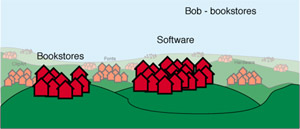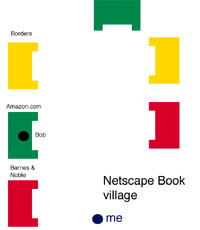
Going through a few interactions of a design had an interesting effect. I believe that the four aspects that Netscape has defined are incorrect. I believe that in order to provide a service that people would want, that site must be immersive, intuitive, and have a sense of community. For that reason, I have not completely followed the directions. However, as you will read, this idea came from spending some time exploring this problem, and not just out of the blue.
My first idea was to create a town set in the wild west.. In this town were a few buildings, one each for software, commerce and community. Also, there was a horse waiting by the center of town for the user. The idea was that the scene was to represent the wilderness that seems significant to the people who flourished during that era. To find content, there was also a horse that the user could "ride" to other destinations on the web. So, the idea was that the user could ride into a town and find out what information was to be had in that village, and then move on to other towns that had other more relevent information. However, there were a number of flaws with this design. The most significant was that the information was not grouped in a way that made it easy for the user to navigate. If one is to create a sense of immersion, we had better not have users feel that they cannot have the computer work as a natural extension of the user..
A second idea was to create a series of islands and a lighthouse.
These drawings, more than anything else, helped me to understand what kind
of information I wanted to be able to present to the user, and gave me
a framework for how I wanted to organize the information. The idea
was quite simple: on the mainland, there was a lighthouse(which turns out
to be Netscape's home page), a bank, which represented commerse, and a
warehouse structure that signified the software industry as described in
the assignment. Off the mainland was a very large expanse of oceans,
with a great number of islands. Each of these islands was to represent
some segment of the web (content-wise). While this seemed like it
would provide the information I wanted to convey, it seemed a little too
cutesy, and did not cater, at least in my opinion, to the types of folks
who spend a lot of time on the web. Also, the buildings that were on the
mainland seemed to be arbitrary and not easily accessible for a particular
reason.
 |
So, after all of this, I went to a very basic design. The idea is that you are looking out over a number of villages. Each of these villages represent some category of information on the web. Close to each of these villages would be other villages that would be of a similar, but not quite the same, category. Of note, which I could not depict with these images, was the idea that the machine would remember what villages you had visited most frequently, and keep those closest to the user. |
 |
The one exception here is community. As you see at the top of the page at the right is a little thing that says "Bob". Well, you see, Bob is a friend of yours, and he happens to be surfing the web, just like you. Wouldn't it be nice if you had a few extra minutes if you could go over and see what he's up to. The way this might work is that you have, as you set up Netscape, given some other users access to know where you are on the web. Of course, this could be turned off for privacy reasons, but wouldn't it be nice if one of your friends came up and started a chat with you while you were searching Amazon.com? |
Or, look at the situation from another angle. You now work for amazon.com. Bob, it turns out, is one of your best customers. In fact, amazon.com and Bob have a great relationship. So much so that Bob has given you his information about when he comes into amazon.com. You, knowing that Bob is in-the-house, may want to open up a chat session with Bob and just find out how he is doing today. Maybe you could even answer a few questions for him if he needs recommendations.
Or, from yet another point of view, you could have your settings in
Netscape be set to public. This might mean that everyone who is in
the Hamlet on the Holodeck page could see that you was also visiting
this page. At the bottom of this page is a chat window in which you
could ask the other people (who we don't already know) their thoughts on
this book. These other people would have to have their profile set
so that they can be seen publically, but if they were set to a public profile,
these people could collaborate with others who have similar interests.
That is basically my idea. I would like to have the web organized
in a more visually comprehensible way. Additionally, it would be
really nice if we knew what friends, customers, or business colleagues
are doing on the web. Of course, it is incumbent upon that other
person to share the information about what they are doing on the web with
you, but if they did it would greatly open up the web to a greater sense
of both community and immersion.